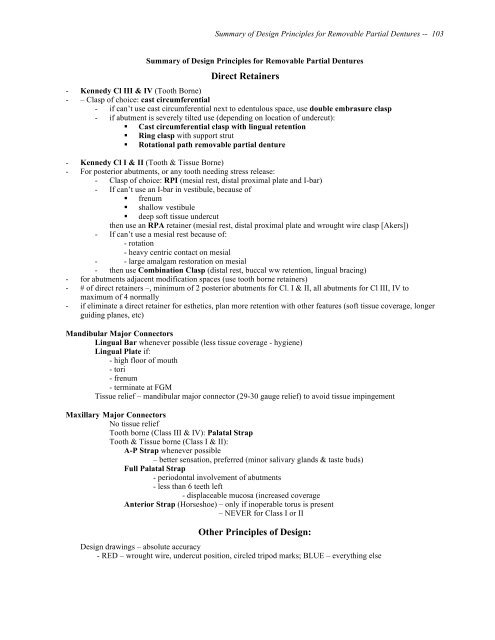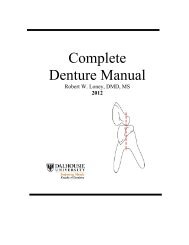RPD Manual 11 - Removable Prosthodontics - Dalhousie University
RPD Manual 11 - Removable Prosthodontics - Dalhousie University
RPD Manual 11 - Removable Prosthodontics - Dalhousie University
You also want an ePaper? Increase the reach of your titles
YUMPU automatically turns print PDFs into web optimized ePapers that Google loves.
Summary of Design Principles for <strong>Removable</strong> Partial Dentures -- 103<br />
Summary of Design Principles for <strong>Removable</strong> Partial Dentures<br />
Direct Retainers<br />
- Kennedy Cl III & IV (Tooth Borne)<br />
- – Clasp of choice: cast circumferential<br />
- if can’t use cast circumferential next to edentulous space, use double embrasure clasp<br />
- if abutment is severely tilted use (depending on location of undercut):<br />
! Cast circumferential clasp with lingual retention<br />
! Ring clasp with support strut<br />
! Rotational path removable partial denture<br />
- Kennedy Cl I & II (Tooth & Tissue Borne)<br />
- For posterior abutments, or any tooth needing stress release:<br />
- Clasp of choice: RPI (mesial rest, distal proximal plate and I-bar)<br />
- If can’t use an I-bar in vestibule, because of<br />
! frenum<br />
! shallow vestibule<br />
! deep soft tissue undercut<br />
then use an RPA retainer (mesial rest, distal proximal plate and wrought wire clasp [Akers])<br />
- If can’t use a mesial rest because of:<br />
- rotation<br />
- heavy centric contact on mesial<br />
- - large amalgam restoration on mesial<br />
- then use Combination Clasp (distal rest, buccal ww retention, lingual bracing)<br />
- for abutments adjacent modification spaces (use tooth borne retainers)<br />
- # of direct retainers –, minimum of 2 posterior abutments for Cl. I & II, all abutments for Cl III, IV to<br />
maximum of 4 normally<br />
- if eliminate a direct retainer for esthetics, plan more retention with other features (soft tissue coverage, longer<br />
guiding planes, etc)<br />
Mandibular Major Connectors<br />
Lingual Bar whenever possible (less tissue coverage - hygiene)<br />
Lingual Plate if:<br />
- high floor of mouth<br />
- tori<br />
- frenum<br />
- terminate at FGM<br />
Tissue relief – mandibular major connector (29-30 gauge relief) to avoid tissue impingement<br />
Maxillary Major Connectors<br />
No tissue relief<br />
Tooth borne (Class III & IV): Palatal Strap<br />
Tooth & Tissue borne (Class I & II):<br />
A-P Strap whenever possible<br />
– better sensation, preferred (minor salivary glands & taste buds)<br />
Full Palatal Strap<br />
- periodontal involvement of abutments<br />
- less than 6 teeth left<br />
- displaceable mucosa (increased coverage<br />
Anterior Strap (Horseshoe) – only if inoperable torus is present<br />
– NEVER for Class I or II<br />
Other Principles of Design:<br />
Design drawings – absolute accuracy<br />
- RED – wrought wire, undercut position, circled tripod marks; BLUE – everything else















